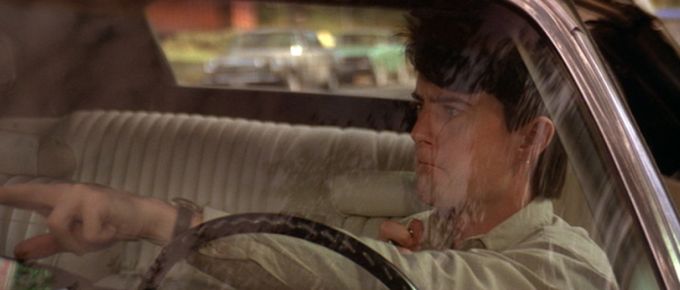 Back to selection
Back to selection
The Blue Velvet Project
Blue Velvet, 47 seconds at a time by Nicholas Rombes
The Blue Velvet Project, #82

Second #3854, 64:14
“I saw The Yellow Man come out and meet up with a well-dressed man carrying an alligator briefcase,” Jeffrey tells Sandy, as we see him snapping a picture with his rigged-up camera-in-a-shoebox, a strange, analog echo of the Lumière brothers’ early motion picture camera. The sequence is reminiscent of a similar one (also involving doubles) in Brian De Palma’s Dressed to Kill, when Kate’s (Angie Dickinson’s) son Peter (Keith Gordon) has suspicions about Dr. Elliott (Michael Caine) and concocts a camera set-up to photograph the entry to his office. The whole operation is so dead-on: the detective’s determination in Jeffrey’s face, the elaborate string contraption he uses to snap the pictures, the hushed seriousness of his voice as the narrates to Sandy what he’s seen.
What’s easy to forget during this sequence is that what we’re being shown in this frame isn’t what Jeffrey saw, but what the camera filming Blue Velvet saw, as opposed to the shot from the previous post, which actually depicts Jeffrey’s flashback from his point of view. This shot at second #3854 is what we might call implied memory information; it reflects how Jeffrey—as he retells the story to Sandy at Arlene’s later that day—might have imagined himself as he took the photos. It’s interesting: Sandy can’t see these flashbacks. She simply hears what Jeffrey says. But is it implied that Jeffrey can see them? Are we to understand that, as he’s talking to Sandy about what happened, he’s picturing what we, as the audience, are seeing? Or is this visual information outside of both Jeffrey and Sandy, existing for our sake alone, to help give a settled shape and form to the narrative?
In a sense, what does it matter? We are woven so tightly into the narrative fabric of the film that that whether this is an image of Jeffrey remembering and picturing himself or simply a shot originating outside his psychological world (or some combination of both) seems to be a meaningless distinction. And yet, in a film about what lies beneath the surface of things and the shifting meaning of archetypal signs (i.e., The Blue Lady, The Yellow Man, The Well-Dressed Man, the ear, the word “Lincoln,” etc.) the question about the knowledge of the camera versus the knowledge of the characters is fundamental to the epistemological architecture of Blue Velvet itself. Which is to say: in a movie about the pleasures of the dark unknown, the ambiguous knowledge of the camera is yet another layer of mystery.
Over the period of one full year — three days per week — The Blue Velvet Project will seize a frame every 47 seconds of David Lynch’s classic to explore. These posts will run until second 7,200 in August 2012. For a complete archive of the project, click here. And here is the introduction to the project.

